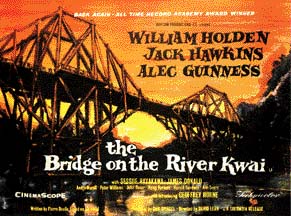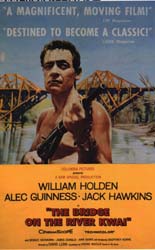


A Film Review Copyright Dragan Antulov 1999
 Once upon a time, there were movies called "larger than
life". They appeared in 1950s, in order to help Hollywood
survive the challenge issued by the new medium of
television. Such films featured stuff small screen could
not: cinemascope, bright colours, exotic locations, truly
epic stories and spectacles with thousands of extras. Some
of those films slid into obscurity, others got their Academy
Awards and became the most precious part of cinema legacy,
often causing filmophiles to lament good old times.
Undisputed master of that genre was David Lean, one of the
greatest British directors who ever lived. In the latter
part of his career he made five such great films, and two of
them are regarded as masterpieces. The first one was THE
BRIDGE ON THE RIVER KWAI, 1957 war spectacle than won seven
Academy awards and later became praised as one of the best
anti-war films ever made.
Once upon a time, there were movies called "larger than
life". They appeared in 1950s, in order to help Hollywood
survive the challenge issued by the new medium of
television. Such films featured stuff small screen could
not: cinemascope, bright colours, exotic locations, truly
epic stories and spectacles with thousands of extras. Some
of those films slid into obscurity, others got their Academy
Awards and became the most precious part of cinema legacy,
often causing filmophiles to lament good old times.
Undisputed master of that genre was David Lean, one of the
greatest British directors who ever lived. In the latter
part of his career he made five such great films, and two of
them are regarded as masterpieces. The first one was THE
BRIDGE ON THE RIVER KWAI, 1957 war spectacle than won seven
Academy awards and later became praised as one of the best
anti-war films ever made.
The plot of this film is based on the novel by French author Pierre Boulle (whose work would later inspire another great film, PLANET OF THE APES). However, the novel, as well and the film, found its basis in one often forgotten but ghastly episode of World War Two. In 1942, following Pearl Harbor, Japanese forces overcame weak British defences and conquered Malaya and Burma. However, the Jewel of the Crown - India - remained out of their reach, not because of weakened British defences, but because of their own logistical problems. For the supply of their troops on Burmese front, Japanese couldn't rely on their navy, already over-stretched with surprisingly successful Pacific conquests. So, the land supply route had to be made, and Japanese began to build the railway that would connect Japanese-controlled Burma with the supply bases in Thailand. Such task was hard, because the railroad had to be built through the hundred kilometres of thick, wild jungle. The least of all problems was the workforce - Japanese used tens of thousands of captured Allied soldiers and hundreds of thousands of natives as slave labour. After sixteen months of hard labour the railroad was finished, but the death toll among the captives, exhausted by heat, disease and Japanese mistreatment was horrible, and the railroad deserved its nickname Railway of Death.
 The film begins in February 1943, in the Prison Camp No. 16,
commanded by Colonel Saito (played by Sessue Hayakawa), who
is faced with a problem. He is ordered to finish the bridge
over the river Kwai before May 12th, but the task is almost
impossible, since the almost all camp prisoners succumbed to
the harsh conditions of prison life. Their replacement comes
in the form of battalion of British prisoners, commanded by
Colonel Nicholson (played by Alec Guiness). Nicholson is
obsessed with order and military discipline and wants to
maintain it, even as prisoner; so he refuses Saito's orders
to take part in manual labour, which is, according to Geneva
Convention, forbidden for officers. Of course, that leads to
dramatic confrontation and Saito wants to make Nicholson
change his mind through torture. While those two Colonels
are obsessed with desire to save face, US Navy Commander
Shears (played by William Holden) is more concerned with his
own survival; knowing that his chances in the jungle are
better than in the camp, he escapes. Few weeks later, Saito,
pressed with mounting deadline and frustrated with the lack
of progress, concedes defeat and allows Nicholson and other
officers to be spared from manual labour. Instead of
gloating, Nicholson decides to actually co-operate with
Saito and help him build the bridge; in his mind, this
successful completion of such task would regain dignity,
moral and discipline of his men. In the meantime, Shears has
miraculously survived the jungle and reached the safety of
British- controlled Ceylon. There he is shown to be
impostor, enlisted man who had took the false identity of an
officer in order to get privileges. In order to evade court
martial, he accepts the deal that brings him back to the
last place he would want to go - to the bridge on the river
Kwai, this time as a member of commando team, led by Major
Warden (played by Jack Hawkins), determined to blow up still
unfinished bridge.
The film begins in February 1943, in the Prison Camp No. 16,
commanded by Colonel Saito (played by Sessue Hayakawa), who
is faced with a problem. He is ordered to finish the bridge
over the river Kwai before May 12th, but the task is almost
impossible, since the almost all camp prisoners succumbed to
the harsh conditions of prison life. Their replacement comes
in the form of battalion of British prisoners, commanded by
Colonel Nicholson (played by Alec Guiness). Nicholson is
obsessed with order and military discipline and wants to
maintain it, even as prisoner; so he refuses Saito's orders
to take part in manual labour, which is, according to Geneva
Convention, forbidden for officers. Of course, that leads to
dramatic confrontation and Saito wants to make Nicholson
change his mind through torture. While those two Colonels
are obsessed with desire to save face, US Navy Commander
Shears (played by William Holden) is more concerned with his
own survival; knowing that his chances in the jungle are
better than in the camp, he escapes. Few weeks later, Saito,
pressed with mounting deadline and frustrated with the lack
of progress, concedes defeat and allows Nicholson and other
officers to be spared from manual labour. Instead of
gloating, Nicholson decides to actually co-operate with
Saito and help him build the bridge; in his mind, this
successful completion of such task would regain dignity,
moral and discipline of his men. In the meantime, Shears has
miraculously survived the jungle and reached the safety of
British- controlled Ceylon. There he is shown to be
impostor, enlisted man who had took the false identity of an
officer in order to get privileges. In order to evade court
martial, he accepts the deal that brings him back to the
last place he would want to go - to the bridge on the river
Kwai, this time as a member of commando team, led by Major
Warden (played by Jack Hawkins), determined to blow up still
unfinished bridge.
Usually, when we are talking about anti-war films, wars depicted in them are those that have gained reputation of senseless slaughter, like WW1 and Vietnam. WW2, as much clearer example of Good vs. Evil, seemed like unsuitable example for anti-war message. But not for David Lean, dedicated pacifist, who probably had rough time reconciling his own beliefs with ugly reality of Britain being threatened by Hitler. That author was probably the most suitable for this film that very explicitly equals war with madness. Lean wasn't the only one who had troubles because of his beliefs - screenwriters Carl Foreman and Michael Wilson were branded as alleged Communists and blacklisted by Hollywood studios, which erased their names from movie credits (restored many years later, together with "Oscars", originally given only to non-English-speaking novel author Boulle).
War as madness in this film is shown through four memorable characters, each of them displaying different levels of sanity, as well as different ways such madness manifests itself. The main and most complex and tragic character is, of course, Colonel Nicholson. This role by Alec Guiness, who would get "Oscar" for it, is one of the best in the history of cinema and much better than Guiness' latter and better known incarnation as Obi Wan Kenoby in STAR WARS. Here he portrays heroic, but deeply flawed individual, obsessed with the idea to maintain order and civilisation even in the situations when such things clearly don't exist anymore. One illusion follows another and he slowly and gradually slides into madness, often deceiving the audience. In the beginning, his stubborn refusal to bend to his captor could be viewed as an act of heroic defiance; but, later, following the same logic, he becomes a traitor instead of a hero.
 His prime antagonist is portrayed by excellent and often
neglected Asian actor Sessue Hayakawa. Colonel Saito is on
the surface looks like nothing more than generic sadistic
villain, but later he is revealed to be as psychologically
troubled as his prisoners are troubled physically. His
previous failure as artist, and failure as engineer could
only lead to his ultimate failure as soldier, already hinted
with the post of prison camp commander - most humiliating
task for the military built on ancient tradition of no
surrender. Desperate desire to save face makes him as
stubborn and mad as Nicholson, and that madness would
express itself with suicidal intentions that are unimpeded
even with the apparent success of his project.
His prime antagonist is portrayed by excellent and often
neglected Asian actor Sessue Hayakawa. Colonel Saito is on
the surface looks like nothing more than generic sadistic
villain, but later he is revealed to be as psychologically
troubled as his prisoners are troubled physically. His
previous failure as artist, and failure as engineer could
only lead to his ultimate failure as soldier, already hinted
with the post of prison camp commander - most humiliating
task for the military built on ancient tradition of no
surrender. Desperate desire to save face makes him as
stubborn and mad as Nicholson, and that madness would
express itself with suicidal intentions that are unimpeded
even with the apparent success of his project.
Another military madman in this Siamese jungle comes in the form of Major Warden, played by excellent Jack Hawkins. While Saito and Nicholson became obsessed with duty and order, Warden sees war as an adventure, opportunity to have some fun by blowing up bridges and buildings. He couldn't care less about discipline and formal rules of war, but, unfortunately, he doesn't care about the fatal consequences his adventurous approach to war could have on men under his command.
Voices of reason seem few in this lunatic asylum. One of them is Shears, character often cited by some critics as unbelievable and unnecessary, written only to bring American crowds to theatres. William Holden plays him as cynic, flawed man, but someone most of us could relate to. His course of actions might seem cowardly or unethical (enjoying undeserved privileges of rank or frolicking with beautiful nurses while his fellow men bleed on the battlegrounds), but they are quite understandable in the context of his experiences. The opposite thing - lack of experience - is something that bothers Lieutenant Joyce, played by Geoffrey Horne, who suffers from fatal inability to kill another human being, even when such course of action is mandated by circumstances. But only the character of Major Clipton happens to be the true voice of reason and his final comments at the end are the words that belong to the author of this film.
1x.jpg) Strong acting talent in this film was accompanied by superb
directing. David Lean spent a great deal of time making this
film and it shows on the screen. The shots are long, but
they allow the viewers to concentrate on the characters and
their subtle gestures, as well as many interesting details.
Photography by Jack Hildyard was superb, with the great use
of Sri Lankan jungle locations that provide claustrophobic
and depressive atmosphere for the film. Musical score by
Malcolm Arnold is also very suggestive, but only the
"Colonel Bogey March" remains in memory as one of the most
catching and popular tunes in the history of film music.
Strong acting talent in this film was accompanied by superb
directing. David Lean spent a great deal of time making this
film and it shows on the screen. The shots are long, but
they allow the viewers to concentrate on the characters and
their subtle gestures, as well as many interesting details.
Photography by Jack Hildyard was superb, with the great use
of Sri Lankan jungle locations that provide claustrophobic
and depressive atmosphere for the film. Musical score by
Malcolm Arnold is also very suggestive, but only the
"Colonel Bogey March" remains in memory as one of the most
catching and popular tunes in the history of film music.
THE BRIDGE ON THE RIVER KWAI is almost perfect film, brilliantly written, acted and directed and one of the rare examples of "Oscar" winners that actually passed the test of time. Of course, there are some flaws, but they are minor. Some may argue that the life of Allied soldiers in Japanese POWs, although still very grim according to this film, was actually much harder in real life. Conflict between Saito and Nicholson was simply unimaginable under such brutal conditions; this film was often criticised by surviving POWs for portraying Japanese guards as kinder and gentler than they actually were. Also, the final showdown, although powerful, in the film seems a little bit melodramatic.
However, despite those flaws, THE BRIDGE ON THE RIVER KWAI still remains undisputed masterpiece, an excellent example of one great film-making talent and thought-provoking cinema. All those with intention to educate themselves about war through movies must see this one.
RATING: 9/10 (++++)
Review written on November 27th 1999 From: Dragan Antulov <dragan.antulov@st.tel.hr>
Dragan Antulov a.k.a. Drax
Fido: 2:381/100
E-mail: dragan.antulov@st.tel.hr
E-mail: drax@purger.com
E-mail: dragan.antulov@altbbs.fido.hr
This film was available as a 400ft cut-down from Columbia Pictures, it was also at one time released complete on Super 8mm for hire only. You may be lucky and find a used copy. Incidentally I have a 400ft version from Columbia in German.
Available on DVD |
![]()
This page was last updated 02 Dec 2002